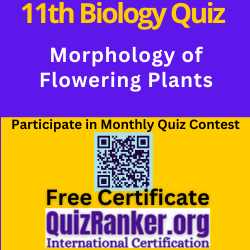Enhance your knowledge with our Morphology of Flowering Plants MCQ Test for 11th Biology Chapter 5. This MCQ Test covers plant structures, flower parts, and leaf types to help you understand flowering plant morphology better. Morphology of Flowering Plants Class 11 MCQ for NEET
Morphology of Flowering Plants MCQ Test
Attempt Chapter wise 11th biology MCQ Test and Monthly Quiz contest of Biology 11th grade.
You can become Morphology of Flowering Plants MCQ topper through our quiz. Simply practice chapterwise mcq and attempt monthly quiz contest. This is Morphology of Flowering Plants MCQ self study type assessment.
About Morphology of Flowering Plants Class 11 MCQ online Test
Flowering plants vary greatly in shape, size, structure, nutrition, life span, habit, and habitat. They have well-developed root and shoot systems. Roots can be tap roots (common in dicots) or fibrous roots (common in monocots). Roots may also modify for food storage, support, or respiration.
The shoot system includes stems, leaves, flowers, and fruits. Stems have nodes and internodes, multicellular hairs, and grow towards light (phototropic). Leaves grow from nodes, are green for photosynthesis, and vary in shape, size, and edge (margin).
Flowers are modified shoots for sexual reproduction, arranged in different inflorescences, and vary in structure, symmetry, ovary position, and petal arrangement. After fertilization, the ovary turns into fruit and ovules into seeds, which can be monocotyledonous or dicotyledonous. Floral characteristics help classify and identify flowering plants using scientific terms, floral diagrams, and floral formulas.
You can get Morphology of Flowering Plants Class 11 MCQ with Answers on YouTube channel.
10 Question for Morphology of Flowering Plants MCQ Topper
- What is the primary function of the root system in plants?
- In monocotyledonous plants, what type of root system is generally present?
- Which type of symmetry is found in mustard flowers?
- What term is used for flowers having both androecium and gynoecium?
- What is the function of calyx in a flower?
- Which type of leaf arrangement is called “alternate”?
- What is the term for the arrangement of flowers on the floral axis?
- Which floral part is represented by ‘C’ in the floral formula?
- What type of fruit is a tomato classified as?
- In which type of flower are the sepals, petals, and stamens situated below the ovary?
Chapter wise biology 11th grade mcq
Chapter 1 The Living World MCQ Test
Chapter 2 Biological Classification MCQ Test
Chapter 3 Plant Kingdom MCQ Test
Chapter 4 Animal Kingdom MCQ Test
Chapter 5 Morphology of Flowering Plants MCQ Test
Chapter 6 Anatomy of Flowering Plants MCQ Test
Chapter 7 Structural Organisation in Animals MCQ Test
Chapter 8 Cell The Unit of Life MCQ Test
Chapter 9 Biomolecules MCQ Test
Chapter 10 Cell Cycle and Cell Division MCQ Test
Chapter 11 Photosynthesis in Higher Plants MCQ Test
Chapter 12 Respiration in Plants MCQ Test
Chapter 13 Plant Growth and Development MCQ Test
Chapter 14 Breathing and Exchange of Gases MCQ Test
Chapter 15 Body Fluids and Circulation MCQ Test
Chapter 16 Excretory Products and their Elimination MCQ Test
Chapter 17 Locomotion and Movement MCQ Test
Chapter 18 Neural Control and Coordination MCQ Test
Chapter 19 Chemical Coordination and Integration MCQ Test
Source for Study
- Free Study PDF Source
- QuizRanker org YouTube Channel View 10 mcq questions with answer for Morphology of Flowering Plants MCQ Test
Total Views: 22


